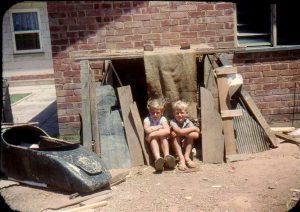 As a child, I used to build the best cubby houses with my sister, Julie. We would collect anything that could be useful to construct the most elaborate structures. We would not always agree on our designs and would occasionally argue about what should go where and what the cubby was for -a fort, a hideout, a doll’s hospital, etc. We would spend a little time playing our make believe games in them and then deconstruct to build something more elaborate. Sometimes our cubbies fell down on top of us. Luckily there were not too severe injuries.
As a child, I used to build the best cubby houses with my sister, Julie. We would collect anything that could be useful to construct the most elaborate structures. We would not always agree on our designs and would occasionally argue about what should go where and what the cubby was for -a fort, a hideout, a doll’s hospital, etc. We would spend a little time playing our make believe games in them and then deconstruct to build something more elaborate. Sometimes our cubbies fell down on top of us. Luckily there were not too severe injuries.
Dad finally got sick of the cubbies popping up in surprise places in the backyard. “Eyesores” he called them but palaces, space stations, pirate ships they were to us. He built us a strong, safe cubby house. We still imagined this to be all manner of things, but it was never the same as our own creation. It also stifled a lot of wonderful learning opportunities that we had building our own. In saying that, I still built a secret door through the fence into the neighbours and a lookout on the roof.
Building these cubbies helped us to learn how to share, solve problems, compromise and co-operate with each other. We would have some big arguments but we learnt from these. We took risks and learned that with risk comes consequence. Standing on the roof of a flimsy structure can lead to significant injury. I have the scars to prove it. I learnt many lessons the hard way.
Play is essential, vital, critical, and fundamental to every child’s social, emotional, physical, and intellectual development. Play is essential for learning and learning is the centre of everything we do at school. This is why we allow children to build cubbies and play with sticks. We know that there will be arguments and disagreements. These occur in all play situations with children whether it be in a game of soccer, football, handball or a game of chess. It is in this real life problem solving that the best, lifelong learning occurs. Just as we do not ban children playing soccer because they argue about the rules, we do not ban all children because some argue or have disagreements. Instead we help the children learn to solve their issues in an increasingly mature manner.
Just like my “Dad built” cubby, our adult designed steel and plastic playgrounds do not attract the same interest, passion and creativity from our children, as do a pile of sticks, logs, branches and planks of wood. Nor do they provide as many wonderful learning opportunities for children to be creative, constructive and to learn essential social skills.
Rather than them creating worlds on Mindcraft, give children some large cardboard boxes, planks of wood, branches and other “junk” so they can create their own imaginary worlds through their cubbies….and learn.

 Imagine you never letting go. Your child would never learn to swim and would always be dependent on you when in the water. Not letting go could put your children eventually in mortal danger of drowning if you are not around.
Imagine you never letting go. Your child would never learn to swim and would always be dependent on you when in the water. Not letting go could put your children eventually in mortal danger of drowning if you are not around.
